26th August, 2025
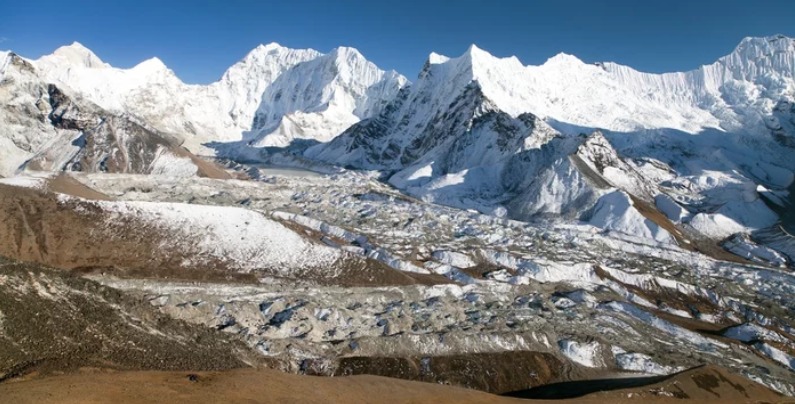
Apr 14, 2024
Island Peak Climbing In October
- What time of year is best to climb Island Peak?
- Can a beginner climb the Island Peak?
- Can you climb Everest in October?
- What is the difficulty grade for Island Peak?
- Island Peak Climbing Weather in October
- Highlights of Island Peak Climbing in October
- How Difficult is Climbing Island Peak
- Can We Do Everest Base Camp with Island Peak
- I Never Climbed a Mountain: Can I Climb Island Peak?
- Island Climbing Peak Permit Cost
- Permit, Guide, and Porter for Island Peak
- How Much Does it Cost to Climb Island Peak?
- Altitude Sickness with Acclimatization
- I Never Climbed a Mountain: Can I Climb Island Peak?
- Packing Lists for Island Peak Climbing
- Tips to Climb Island Peak
- Training for Island Peak
- Final Say
- Island Peak Climbing Packages
Climbing Island Peak in October presents an ideal opportunity for mountaineers to experience the Himalayas at their finest. October marks the post-monsoon season in Nepal, offering stable weather, clear skies, and breathtaking views of the surrounding peaks.
The weather in October is characterized by mild daytime temperatures ranging from 10°C to 15°C (50°F to 59°F) at lower elevations, providing comfortable trekking conditions. Higher altitudes experience cooler temperatures, especially during early mornings and evenings, necessitating warm clothing layers and cold-weather gear. Precipitation is minimal, ensuring dry trails and reducing the risk of rain or snow that could impede climbing progress.
One of the highlights of climbing Island Peak in October is the visibility. Clear skies offer panoramic views of Mount Everest, Lhotse, Nuptse, and Ama Dablam, among other iconic peaks of the Everest region. The route to Island Peak traverses through picturesque Sherpa villages such as Namche Bazaar, Pangboche, and Dingboche, providing opportunities to immerse in Sherpa culture, visit monasteries adorned with prayer flags, and interact with local communities.

ISLAND PEAK CLIMBING
Sherpa Expedition & Trekking (Est.1977) are pleased to announce FOR ADVENTURERS the most awesome, exhilarating & unforgettable climbing and treks on offer anywhere today!...
October is considered peak trekking and climbing season in Nepal, drawing adventurers from around the world. As such, climbers can expect to encounter fellow trekkers and mountaineers on the trail, fostering a sense of camaraderie and shared achievement. Despite the popularity, the route to Island Peak maintains its pristine natural beauty and offers a challenging yet achievable climb for those with basic mountaineering skills.
Preparation for climbing Island Peak in October includes physical conditioning, acclimatization, and packing appropriate gear such as insulated clothing, waterproof layers, sturdy boots, and essential mountaineering equipment. Engaging with experienced guides and porters ensures safety, guidance on route finding, and logistical support throughout the expedition.
Overall, climbing Island Peak in October promises a memorable adventure amidst Nepal's spectacular mountain scenery, cultural richness, and the thrill of summiting a 6,189-meter peak in favorable autumn conditions. It is an opportunity to challenge oneself, appreciate the natural wonders of the Himalayas, and forge lasting memories of a Himalayan climbing expedition.
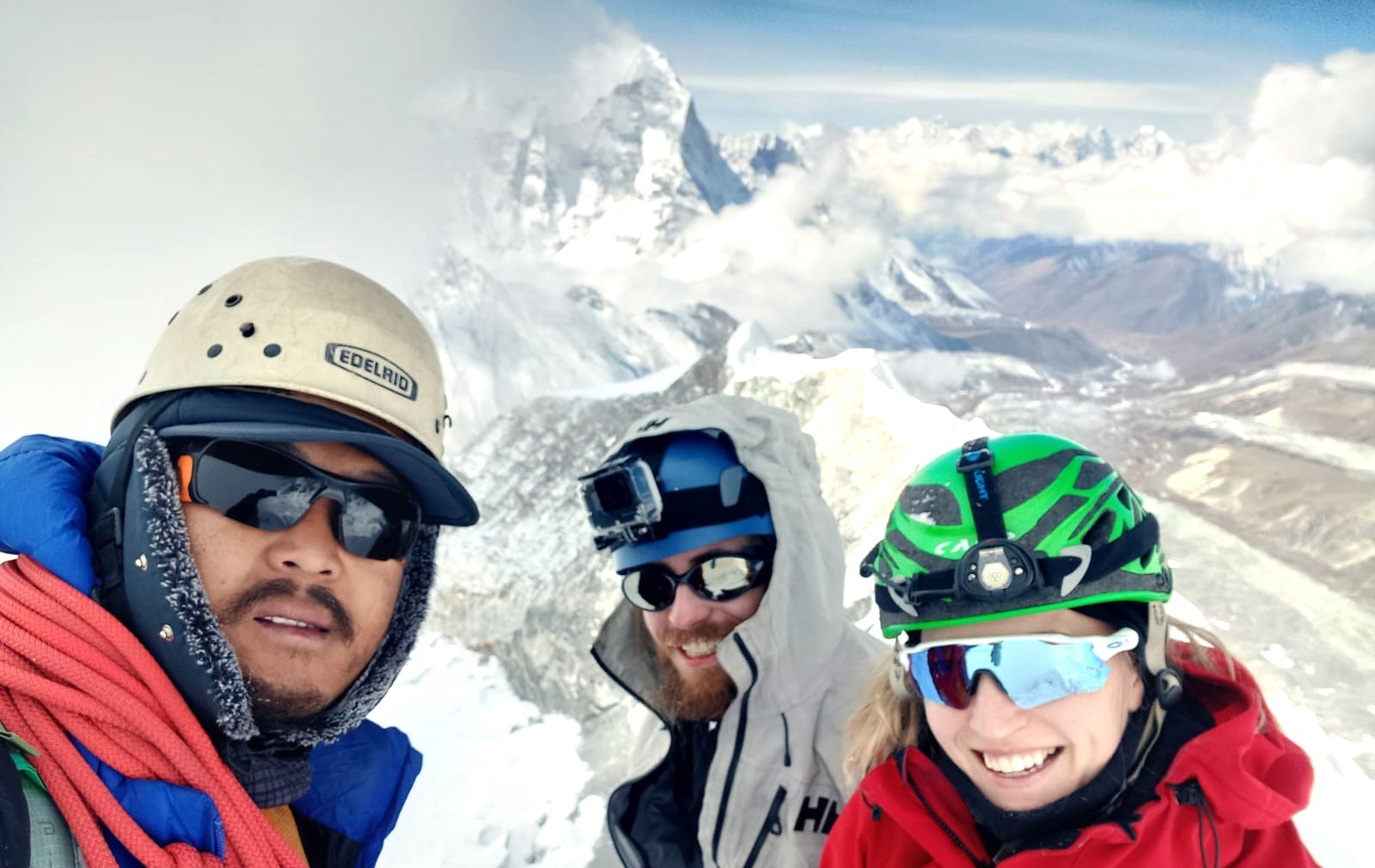
ISLAND PEAK EXPEDITION 15 DAYS
Island Peak, also known as Imja Tse, is a popular peak located in the Khumbu region of Nepal. This peak is a part of the Himalayas and stands tall at a height of 6,189 meters above sea level. Island P...
What time of year is best to climb Island Peak?
The best time of year to climb Island Peak is typically during the post-monsoon season in Nepal, which spans from late September to November. During this period, the weather is relatively stable with clear skies and mild temperatures, making climbing conditions favorable. The reduced precipitation ensures dry trails and minimal risk of snowfall, enhancing safety and visibility during the ascent. Climbers can enjoy stunning views of the surrounding Himalayan peaks and experience comfortable trekking conditions along the route.
Can a beginner climb the Island Peak?
While Island Peak is considered one of the more accessible trekking peaks in the Everest region, it requires basic mountaineering skills and physical fitness. Beginners with prior trekking experience and a good level of fitness can attempt Island Peak under the guidance of experienced guides and with proper acclimatization. The ascent involves navigating through glacier moraines, ascending steep sections, and using basic mountaineering equipment such as crampons and ice axes. Hiring a knowledgeable guide is crucial for safety, route finding, and support throughout the climb.
Can you climb Everest in October?
October is also a favorable month to climb Mount Everest, the world's highest peak. During this time, the weather conditions in the Everest region are typically stable with clear skies and mild temperatures, similar to those conducive for climbing Island Peak. Expeditions to Everest usually coincide with the post-monsoon season in Nepal, offering climbers optimal conditions for summit attempts. Like climbing any high-altitude peak, Everest expeditions require extensive preparation, physical fitness, and acclimatization to mitigate the risks associated with high-altitude mountaineering.
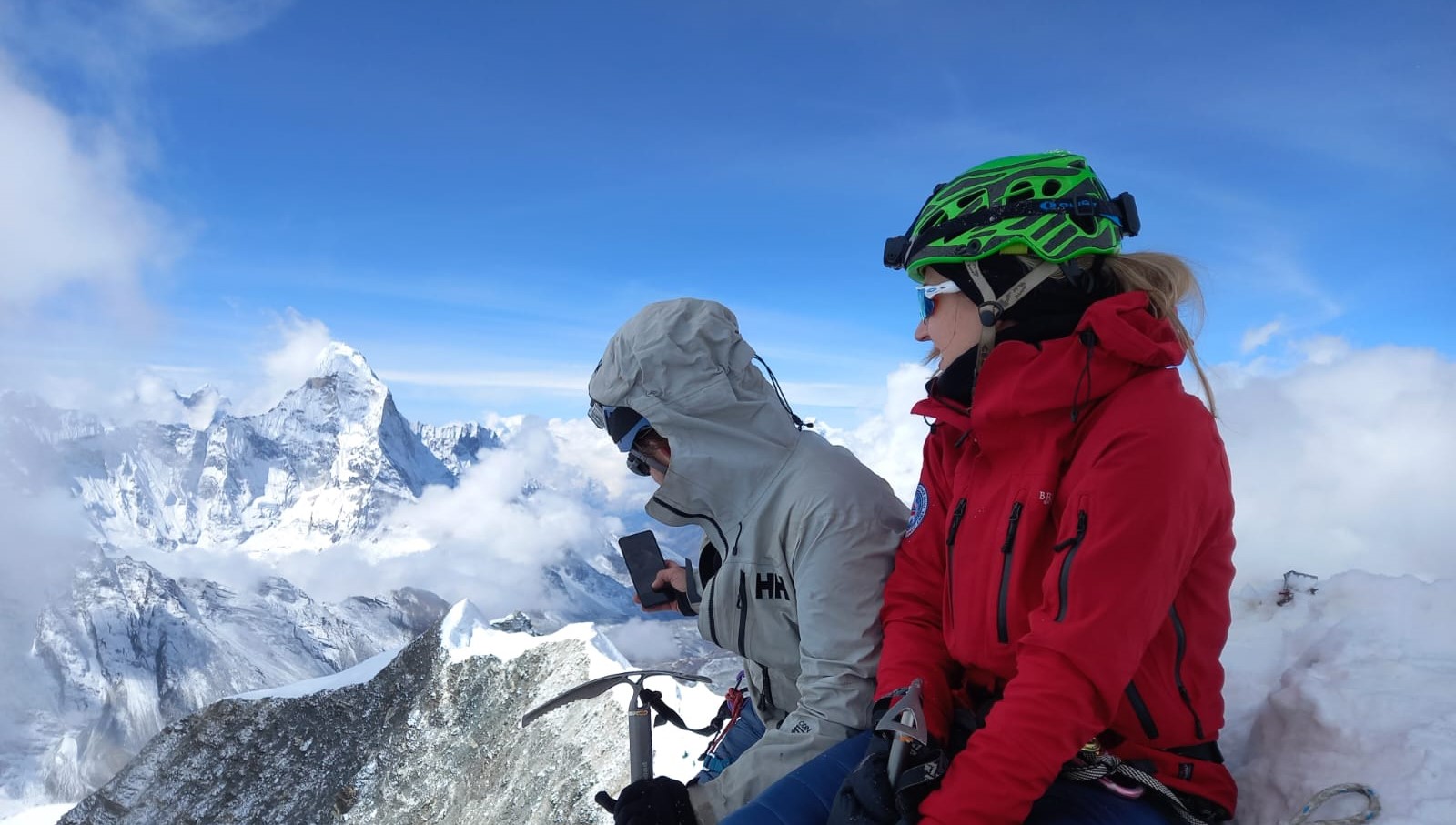
ISLAND PEAK EXPEDITION 14 DAYS
Island Peak Expedition is a 14-day adventure tour that takes you to the heart of the Himalayas, where you can witness the beauty of the mountains, valleys, and glaciers. Island Peak, also known as Imj...
What is the difficulty grade for Island Peak?
Island Peak is classified as a trekking peak by the Nepal Mountaineering Association (NMA) and is rated as a moderate climb. The difficulty grade for Island Peak is considered Alpine PD+ (Peu Difficile Plus), indicating a moderate technical ascent. Climbers need to be comfortable with basic mountaineering skills such as using crampons, ice axes, and ropes. The ascent involves navigating through glacier terrain, ascending steep sections, and negotiating crevasses. While not as technically challenging as some of the higher peaks in the region, Island Peak requires physical fitness, proper acclimatization, and the guidance of experienced guides to ensure a safe and successful climb.
Island Peak Climbing Weather in October
October is one of the best months for climbing Island Peak due to favorable weather conditions in the Himalayas. During this time, the weather is generally stable with clear skies and mild temperatures, making it ideal for climbing and trekking activities. The average daytime temperatures at lower altitudes can range from 10 to 15°C (50 to 59°F), while higher up in the mountains it can drop below freezing, especially at night.
One of the main advantages of October is its dry weather, with minimal precipitation compared to other months. This reduces the risk of encountering heavy snowfall or rain, which can impede climbing progress and pose safety risks. Clear skies also provide stunning panoramic views of the surrounding Himalayan peaks, enhancing the overall experience.

ISLAND PEAK SUMMIT RETURN BY HELICOPTER
Many of us only dream of standing on a tall peak looking down on the world. This is a great climb that will satisfy this desire. Island Peak, also referred to as Imja Tse, is a 6187-meter high peak in...
However, despite the favorable conditions, climbers should always be prepared for sudden weather changes in the mountains. It's essential to pack appropriate clothing layers and gear to handle colder temperatures and potential high-altitude conditions. Overall, October offers a reliable window for Island Peak climbing, balancing manageable weather conditions with breathtaking scenery.
Highlights of Island Peak Climbing in October
October presents an optimal opportunity for climbers to tackle Island Peak, blending favorable weather conditions with breathtaking natural beauty. As climbers ascend towards the peak, they are treated to panoramic views of iconic Himalayan giants like Lhotse, Nuptse, and Everest itself. The clear skies characteristic of October ensure that these vistas remain uninterrupted, providing ample opportunities for memorable photographs and a profound sense of accomplishment.
Moreover, the trek to Island Peak base camp traverses through picturesque Sherpa villages such as Namche Bazaar and Tengboche, offering cultural insights and warm hospitality. The route also passes through Sagarmatha National Park, a UNESCO World Heritage site renowned for its diverse flora and fauna.
Climbing Island Peak in October allows adventurers to avoid the monsoon season's rainfall and the bitter cold of winter, maximizing comfort and safety. The relatively stable weather conditions in October make it easier to navigate the challenging terrain and ascend to the peak's summit, standing at 6,189 meters (20,305 feet).
In essence, October combines ideal weather, stunning landscapes, and cultural immersion, making Island Peak climbing an unforgettable experience for mountaineers and adventurers alike.
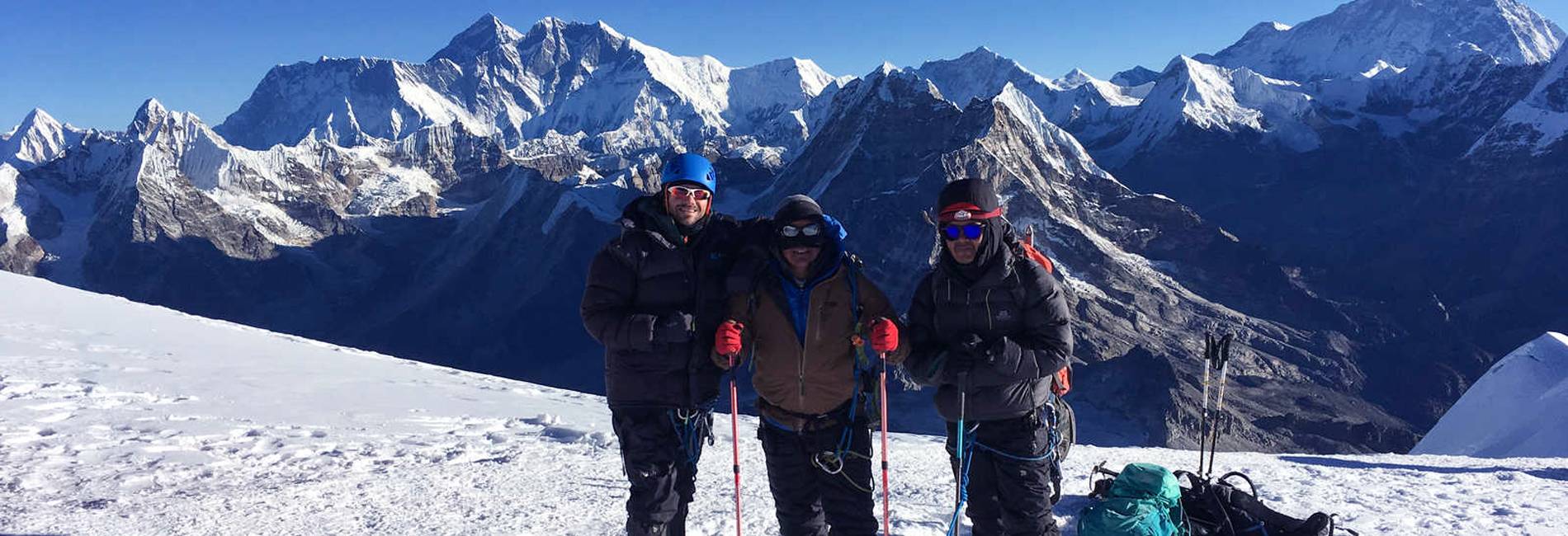
MERA PEAK CLIMBING
Mera Peak Climbing is an exhilarating adventure in Nepal that gives you an opportunity to reach the summit of Mera Peak at more than 6400m above sea level. Actually, it is the highest climbing (w...
How Difficult is Climbing Island Peak
Climbing Island Peak is considered challenging but achievable for trekkers with prior experience in high-altitude trekking and basic mountaineering skills. At 6,189 meters (20,305 feet), it's classified as a trekking peak, meaning it requires technical climbing ability beyond typical trekking but doesn't necessitate extensive mountaineering expertise.
The ascent typically involves crossing glacial terrain and steep slopes, including a final snow and ice slope leading to the summit. Basic techniques like using crampons, ropes, and ice axes are essential for navigating these sections safely. Altitude acclimatization is crucial, and climbers should be prepared for the physical demands of ascending at high altitude.
Despite its challenges, Island Peak is a popular choice due to its stunning views of Everest and neighboring peaks from the summit. The route to Island Peak base camp also offers a cultural immersion into Sherpa communities and the natural beauty of the Khumbu region.
While prior mountaineering experience is beneficial, many climbers successfully summit Island Peak with the guidance of experienced guides and thorough preparation. It's essential for climbers to be in good physical condition, mentally prepared for the altitude, and equipped with proper gear to ensure a safe and enjoyable ascent.
Can We Do Everest Base Camp with Island Peak
Combining an Everest Base Camp trek with an Island Peak climb is a popular option for adventurers seeking a comprehensive Himalayan experience. The journey typically begins with the classic Everest Base Camp trek, which takes trekkers through scenic Sherpa villages, across suspension bridges, and into the heart of Sagarmatha National Park.
Reaching Everest Base Camp (5,364 meters or 17,598 feet) provides a profound sense of accomplishment, surrounded by some of the world's highest peaks. Trekkers then continue towards Island Peak, adding a mountaineering challenge to their adventure.
From Island Peak base camp, climbers ascend gradually, practicing essential mountaineering skills under the guidance of experienced Sherpa guides. The final push to the summit involves negotiating steep ice and snow slopes, culminating in unparalleled views of Everest, Lhotse, and Makalu.
Combining these two adventures allows trekkers to experience both the cultural richness of the Khumbu region and the thrill of summiting a Himalayan peak. It's a journey that demands physical fitness, altitude acclimatization, and a spirit of adventure, offering rewards in the form of stunning landscapes and personal achievement.
Overall, a combined Everest Base Camp and Island Peak expedition promises a truly unforgettable Himalayan adventure, blending trekking, cultural immersion, and mountaineering challenges in one remarkable journey.
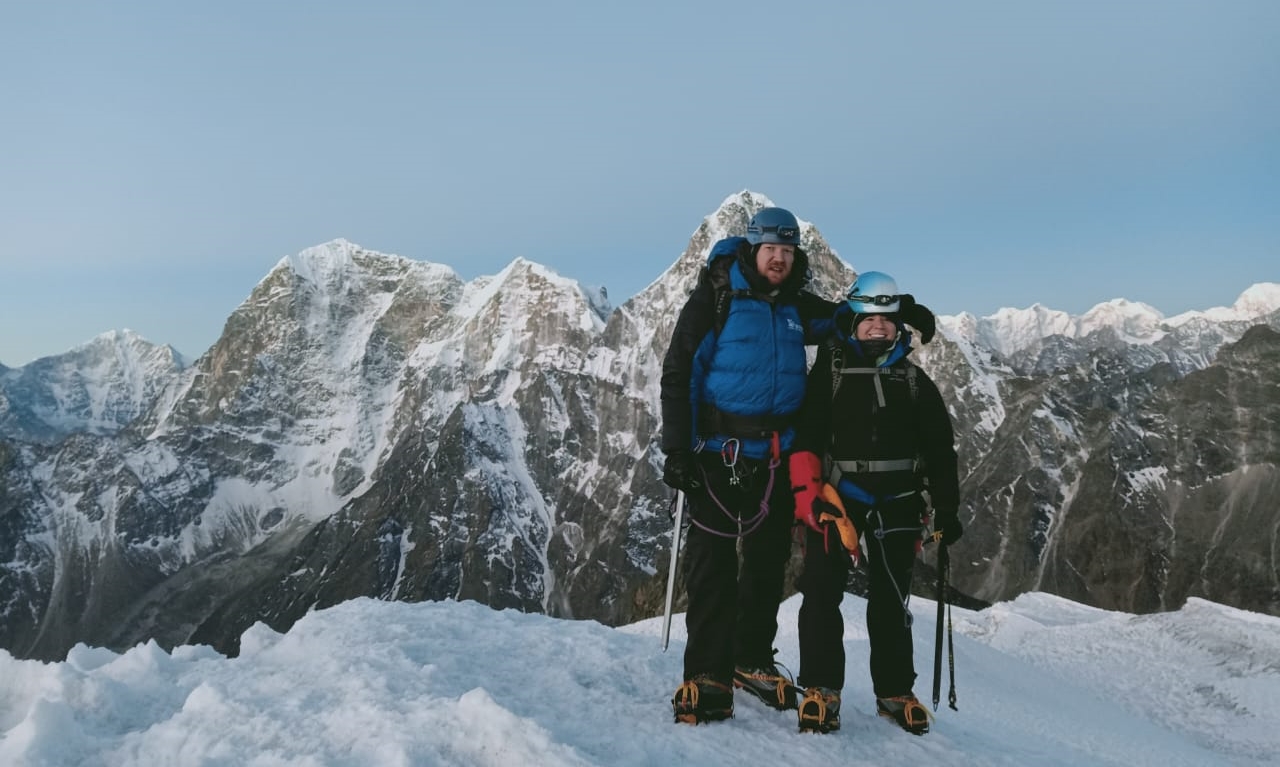
LOBUCHE PEAK CLIMBING
Lobuche East (6,119m/20,075ft), set in Nepal's stunning Khumbu on the Nepalese side of Everest.The best time to go trekking in Nepal is in Autumn (September-November) and in...
I Never Climbed a Mountain: Can I Climb Island Peak?
Climbing Island Peak does not necessarily require previous mountaineering experience, but it does demand a good level of physical fitness, mental preparation, and the ability to acclimatize to high altitudes. As a trekking peak, Island Peak is popular among novice climbers looking to transition from trekking to basic mountaineering. However, it's crucial to undertake proper training and preparation.
Before attempting Island Peak, it's advisable to participate in altitude training, practice basic climbing techniques, and familiarize yourself with using climbing equipment such as crampons and ice axes. Additionally, acclimatization is essential to prevent altitude sickness and ensure a safe ascent.
Many climbers opt to hire experienced guides who provide valuable expertise, assist with route navigation, and ensure safety throughout the journey. With adequate physical preparation, determination, and guidance from experienced professionals, climbers with no prior mountain climbing experience can successfully summit Island Peak, enjoying stunning views of the Everest region from its peak.
Island Climbing Peak Permit Cost
Obtaining a permit for Island Peak is mandatory and involves several components. The permit cost includes fees set by the Nepalese government to regulate climbing activities in the Everest region. As of the latest information, the permit cost for Island Peak typically ranges around USD 250 to USD 500 per person, depending on the season and specific regulations.
In addition to the climbing permit, climbers also need a Sagarmatha National Park entry permit, which costs around USD 30 per person. These permits are essential for legal access to the Khumbu region and its protected areas.
It's important to arrange permits through a registered trekking agency or expedition organizer, as independent applications are not accepted. The agency will handle all necessary paperwork and logistics, ensuring compliance with local regulations and providing support throughout the expedition.
Understanding the permit costs and regulations beforehand helps climbers budget effectively and ensures a smooth administrative process, allowing them to focus on preparing for the physical and mental challenges of climbing Island Peak.
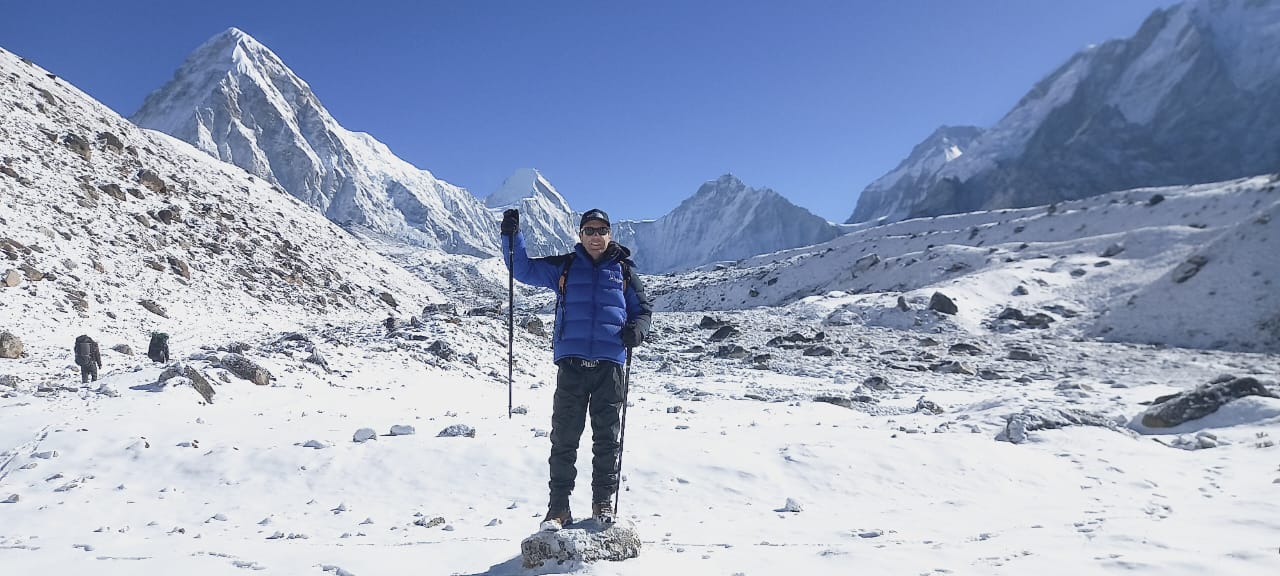
ISLAND AND LOBUCHE PEAK CLIMBING
Lobuche and Island Peak combo climbing expedition is a thrilling adventure that offers a unique opportunity to conquer two popular peaks in the Everest region of Nepal. Lobuche Peak (6,119m) and Islan...
Permit, Guide, and Porter for Island Peak
When planning to climb Island Peak, hiring a guide and possibly a porter is highly recommended, especially for those with limited mountaineering experience. Guides provide essential expertise in navigating the route, handling climbing equipment, and ensuring safety throughout the expedition. They are familiar with the terrain, weather patterns, and potential challenges, offering invaluable support to climbers.
The cost of hiring a guide for Island Peak varies depending on their experience, reputation, and the services included. On average, guide fees can range from USD 20 to USD 50 per day. Additionally, porters may be hired to carry equipment and supplies, easing the physical burden on climbers.
Experienced trekking agencies typically offer package deals that include permits, guide services, and sometimes porter support. These packages streamline logistics and ensure compliance with local regulations, allowing climbers to focus on their ascent without administrative hassles.
Choosing a reputable agency and experienced guides is crucial for a safe and successful climb. They provide logistical support, enhance the overall experience, and contribute to the enjoyment of exploring the stunning landscapes of the Everest region.
How Much Does it Cost to Climb Island Peak?
The total cost of climbing Island Peak varies depending on several factors, including permit fees, guide services, porter support, equipment rental, accommodation, and travel expenses. As a rough estimate, the total cost can range from USD 3,000 to USD 6,000 per person for a standard 16- to 20-day expedition.
Key cost components include:
- Permits: Approximately USD 250 to USD 500 for the climbing permit and USD 30 for the Sagarmatha National Park entry permit.
- Guide and Porter: Guide fees typically range from USD 20 to USD 50 per day, while porter fees are around USD 15 to USD 25 per day.
- Equipment Rental: Costs for renting climbing gear such as crampons, ice axes, harnesses, and helmets vary but can add up to several hundred dollars.
- Accommodation and Meals: Lodging in teahouses along the trekking route and meals can cost around USD 25 to USD 50 per day, depending on the quality and location.
- Travel and Miscellaneous: Additional expenses may include international airfare to Nepal, travel insurance, visa fees, tips, and personal expenses.
Choosing a reputable trekking agency that offers comprehensive packages can provide a clearer breakdown of costs and ensure a well-organized expedition. Budgeting adequately and preparing for unforeseen expenses contribute to a smooth and enjoyable climbing experience on Island Peak.
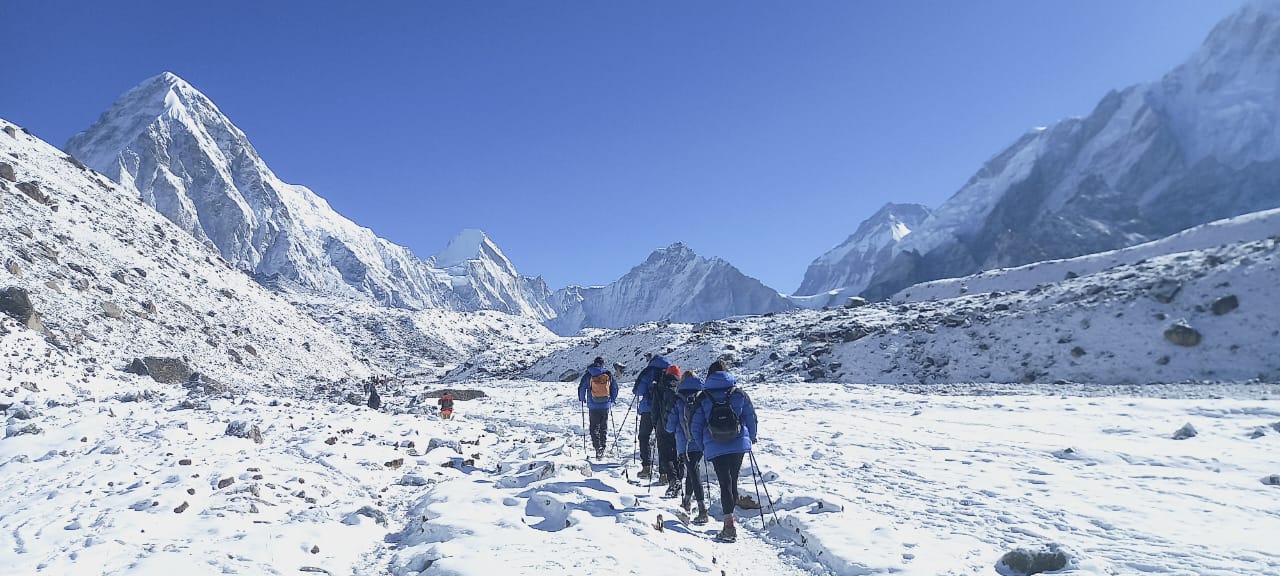
MERA AND ISLAND PEAK CLIMBING
Embark on a thrilling mountaineering adventure like no other with the Mera and Island Peak Climbing expedition crafted by We Sherpa Expedition and Trekking. This exclusive package is designed for adve...
Altitude Sickness with Acclimatization
Altitude sickness, also known as acute mountain sickness (AMS), can affect climbers ascending to high altitudes, including those attempting Island Peak. Symptoms such as headaches, nausea, dizziness, and fatigue can occur when the body fails to acclimatize properly to reduced oxygen levels at higher elevations.
Effective acclimatization is critical to preventing altitude sickness. Climbers should follow recommended guidelines such as:
- Gradual Ascent: Ascend slowly, allowing time for the body to adjust to higher altitudes. It's essential to schedule rest days during the trek to aid acclimatization.
- Hydration and Nutrition: Drink plenty of fluids and maintain a balanced diet to support physical exertion and adaptation to altitude.
- Medication: Some climbers may consider medications like acetazolamide (Diamox) to aid acclimatization, but this should be discussed with a healthcare provider.
- Recognizing Symptoms: Be aware of early signs of altitude sickness and communicate any concerns to guides or fellow climbers.
- Descend if Necessary: If symptoms worsen despite precautions, descend to a lower altitude immediately. Prompt action can prevent serious complications such as high-altitude pulmonary edema (HAPE) or cerebral edema.
By prioritizing acclimatization, maintaining physical fitness, and following expert guidance, climbers can minimize the risk of altitude sickness and safely enjoy the exhilarating experience of climbing Island Peak in the Himalayas.
I Never Climbed a Mountain: Can I Climb Island Peak?
While prior mountain climbing experience is beneficial, climbing Island Peak is achievable for individuals with good physical fitness, determination, and willingness to undergo proper training. As a trekking peak, Island Peak (6,189 meters or 20,305 feet) in the Everest region of Nepal offers a challenging yet accessible introduction to mountaineering. It requires basic climbing skills like using crampons and ice axes, which can be learned during preparatory training.
Before attempting Island Peak, it's crucial to engage in physical conditioning to build endurance and strength. Additionally, acclimatization to high altitudes is essential to prevent altitude sickness. Many climbers choose to hire experienced guides who provide essential support and expertise throughout the ascent.
With adequate preparation, including training, acclimatization, and guidance from experienced professionals, even those without previous mountain climbing experience can successfully summit Island Peak. It's a rewarding achievement that offers breathtaking views of the Himalayas and a profound sense of accomplishment.
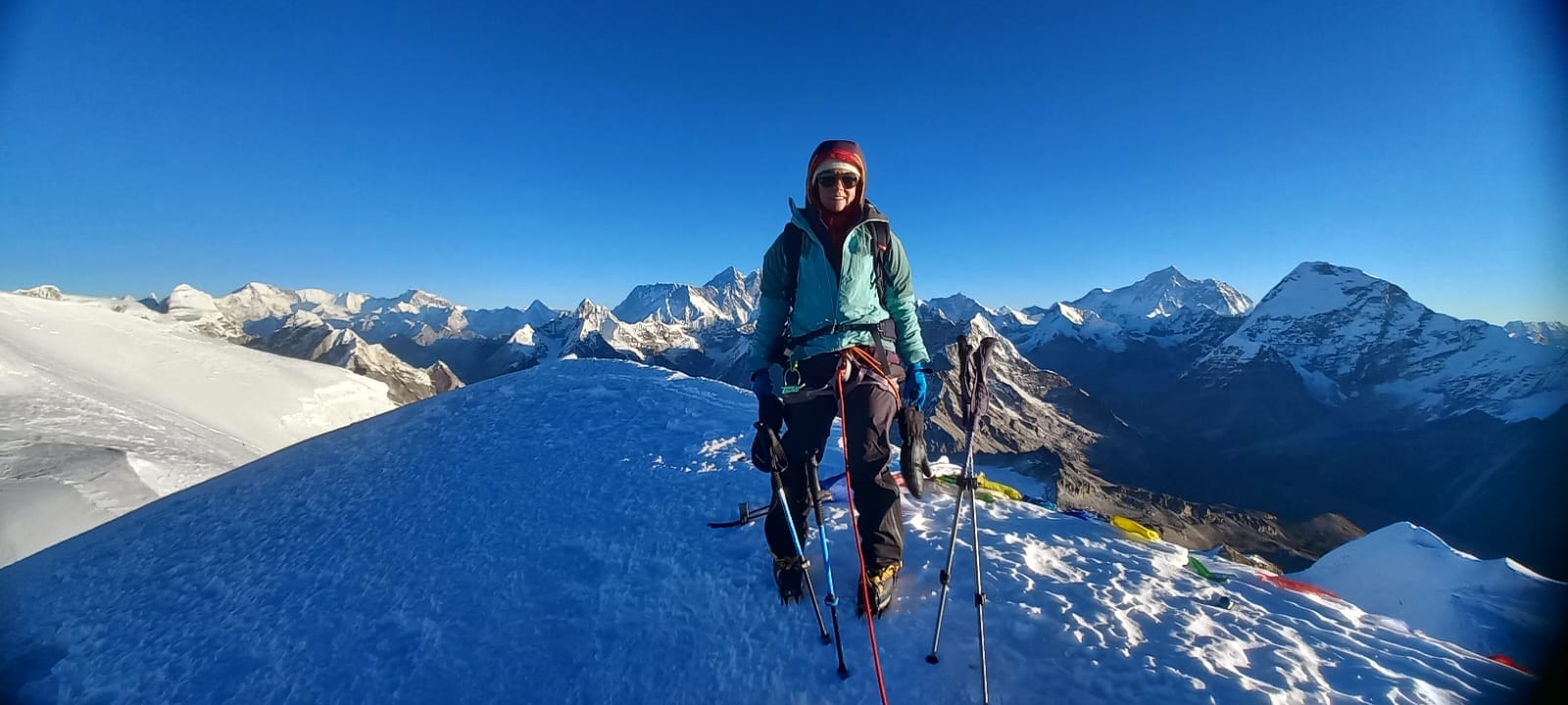
Three Peak Expedition
Embark on an unforgettable journey to the heart of the Himalayas as you conquer three majestic peaks: Mera Peak, Island Peak, and Lobuche Peak. This ultimate adventure combines technical climbing, bre...
Packing Lists for Island Peak Climbing
Packing efficiently for Island Peak climbing involves balancing essential gear with minimal weight to ensure comfort and safety throughout the expedition. Here are key items to include in your packing list:
- Clothing: Layering is essential for adapting to changing temperatures. Pack moisture-wicking base layers, insulated mid-layers, a waterproof and windproof outer shell, gloves, hats, and sturdy trekking pants.
- Footwear: Bring well-broken-in, waterproof trekking boots with ankle support. Also, pack insulated and lightweight mountaineering boots for higher altitudes and crampon use.
- Climbing Gear: Essentials include a climbing harness, helmet, crampons, ice axe, and ropes. Consider renting equipment locally to reduce weight and logistical challenges.
- Sleeping Gear: A four-season sleeping bag rated for cold temperatures and a lightweight sleeping mat for insulation.
- Personal Items: Sunscreen, lip balm, sunglasses, a headlamp with spare batteries, trekking poles, and a water bottle or hydration system.
- Medical and Safety Supplies: Include a basic first aid kit, altitude sickness medications (if recommended by a doctor), and personal medications.
- Documents: Carry your passport, permits, travel insurance details, and emergency contacts in a waterproof pouch.
Pack light but ensure you have all necessary gear for comfort and safety during varying weather conditions in the Himalayas. Check with your trekking agency or guide for any specific recommendations based on current conditions and itinerary.
Tips to Climb Island Peak
Successfully summiting Island Peak requires careful planning, physical preparation, and adherence to safety guidelines. Here are essential tips for a successful climb:
- Physical Conditioning: Build strength, stamina, and cardiovascular fitness through aerobic exercises, hiking, and climbing stairs with a loaded backpack.
- Altitude Acclimatization: Ascend gradually, taking rest days to acclimatize and hydrate adequately to prevent altitude sickness.
- Training in Basic Mountaineering Skills: Familiarize yourself with using crampons, ice axes, ropes, and climbing harnesses before the expedition.
- Follow Expert Guidance: Hire experienced guides who know the terrain, weather patterns, and can provide technical support during the climb.
- Pack Wisely: Carry essential gear and clothing layers suitable for varying weather conditions in the Himalayas.
- Stay Hydrated and Nourished: Drink plenty of fluids and eat nutritious meals to maintain energy levels and aid acclimatization.
- Monitor Weather Conditions: Be prepared to adjust your itinerary based on weather forecasts and follow safety protocols.
By preparing thoroughly, respecting the mountain environment, and listening to your body and guides, you can increase your chances of summiting Island Peak safely and enjoyably.
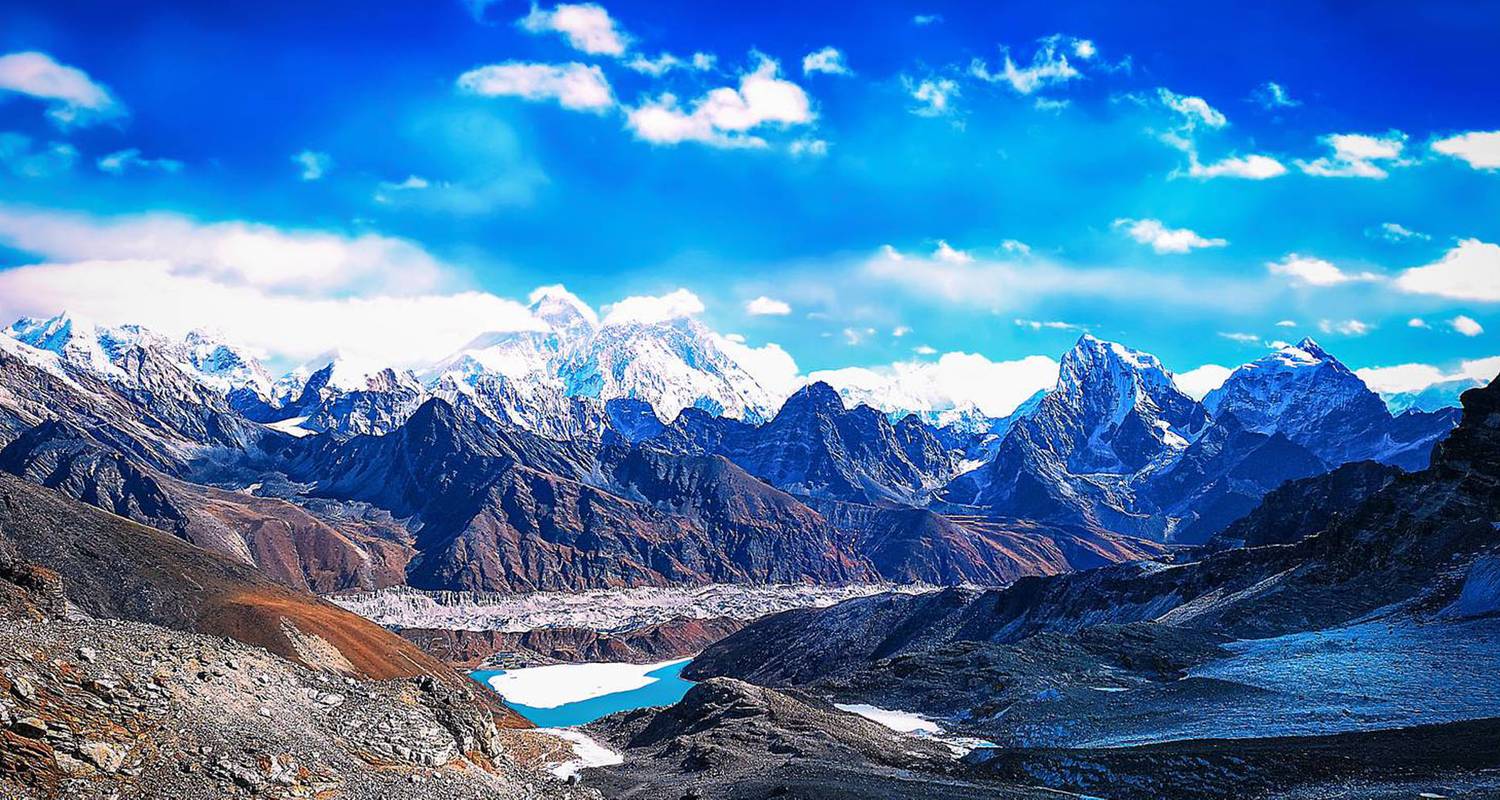
Everest Three High Pass Trek with Island Peak Climbing
The Everest Three High Pass Trek with Island Peak Climbing is an exhilarating and challenging adventure that takes you through the stunning landscapes of the Everest region in Nepal. This 23-25...
Training for Island Peak
Training for Island Peak should focus on building strength, endurance, and acclimatization to high altitudes. Here's a structured approach to prepare for the climb:
- Cardiovascular Fitness: Engage in aerobic exercises such as hiking, running, cycling, and swimming to improve cardiovascular endurance. Aim for at least 3-4 sessions per week, gradually increasing intensity and duration.
- Strength Training: Develop leg and core strength through exercises like squats, lunges, step-ups, and planks. Include upper body exercises such as pull-ups and shoulder presses to support climbing movements.
- Altitude Simulation: If possible, simulate high-altitude conditions using altitude training masks or by hiking at higher elevations to acclimatize your body.
- Practice Climbing Skills: Learn and practice basic mountaineering techniques such as walking with crampons, using an ice axe for self-arrest, and rope handling.
- Long-Distance Hikes: Incorporate long hikes with a loaded backpack to simulate trekking conditions and build endurance.
- Flexibility and Balance: Include yoga or stretching exercises to improve flexibility and balance, crucial for navigating uneven terrain.
- Rest and Recovery: Allow time for rest days between training sessions to prevent overtraining and promote muscle recovery.
Consult with a fitness trainer or mountaineering expert to tailor your training plan based on your current fitness level and specific climbing goals. Adequate preparation enhances your physical performance and enjoyment during the Island Peak expedition.
Final Say
Climbing Island Peak offers an exhilarating challenge and a chance to explore the breathtaking landscapes of the Everest region. While prior mountain climbing experience is beneficial, it's not a prerequisite for success. With thorough preparation, including physical training, acclimatization, and guidance from experienced professionals, even novice climbers can safely summit this iconic Himalayan peak.
Packing wisely with essential gear, following safety protocols, and respecting the mountain environment are crucial for a successful expedition. Engage in cardiovascular and strength training, practice basic mountaineering skills, and acclimatize gradually to prepare effectively for the altitude and challenges ahead.
Ultimately, climbing Island Peak is a transformative experience that rewards perseverance, respect for nature, and the thrill of standing atop one of Nepal's majestic peaks. Embrace the journey with enthusiasm, determination, and a spirit of adventure for an unforgettable Himalayan adventure.

CHULU FAR EAST PEAK CLIMBING
Are you looking for adventure, natural beauty, magnificent snow-capped peaks, and unique cultural experience?This Peak Climbing will give you all the thrills, variety, and the adrenalin rush as you cl...
Island Peak Climbing Packages
Island Peak Summit Return By Helicopter
Island Peak Expedition 14 Days
Island Peak Expedition 15 Days
Everest Three Pass with Island Peak Climbing
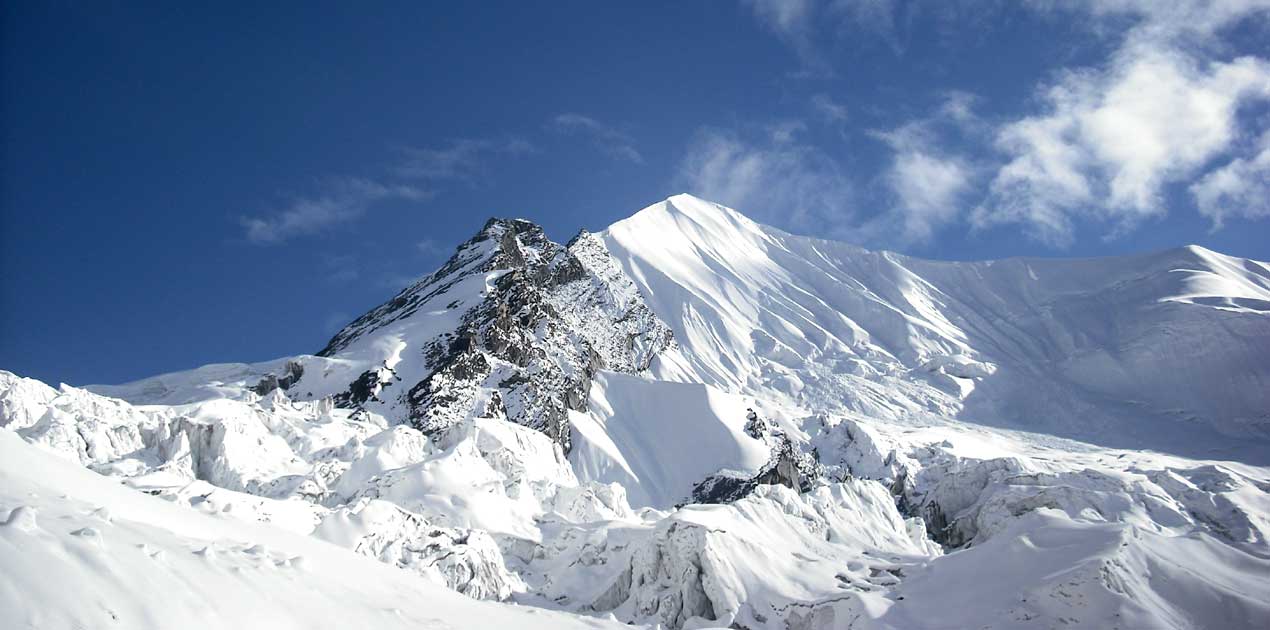
PACHERMO PEAK CLIMBING
Believe in yourself! You have what it takes to summit this beautiful peak in the remote Rolwaling district in the northeast of Nepal – near the Tibetan border. It is physically demanding, but with som...
Any Questions? Let Us Know.
Recent Posts
17th June, 2025


















